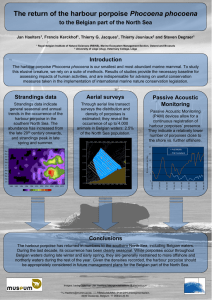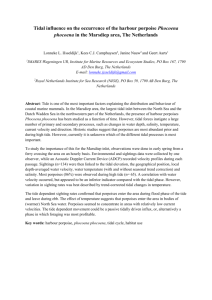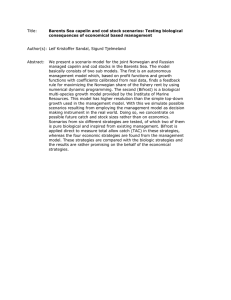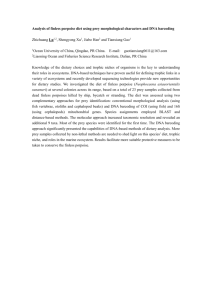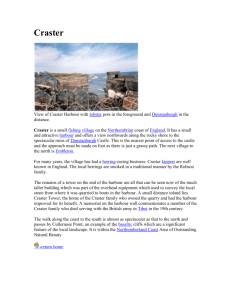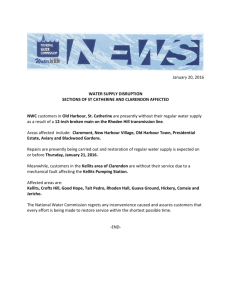This paper not to be cited without prior reference to... International Council for ICES C.M. 1996/ N:7
advertisement
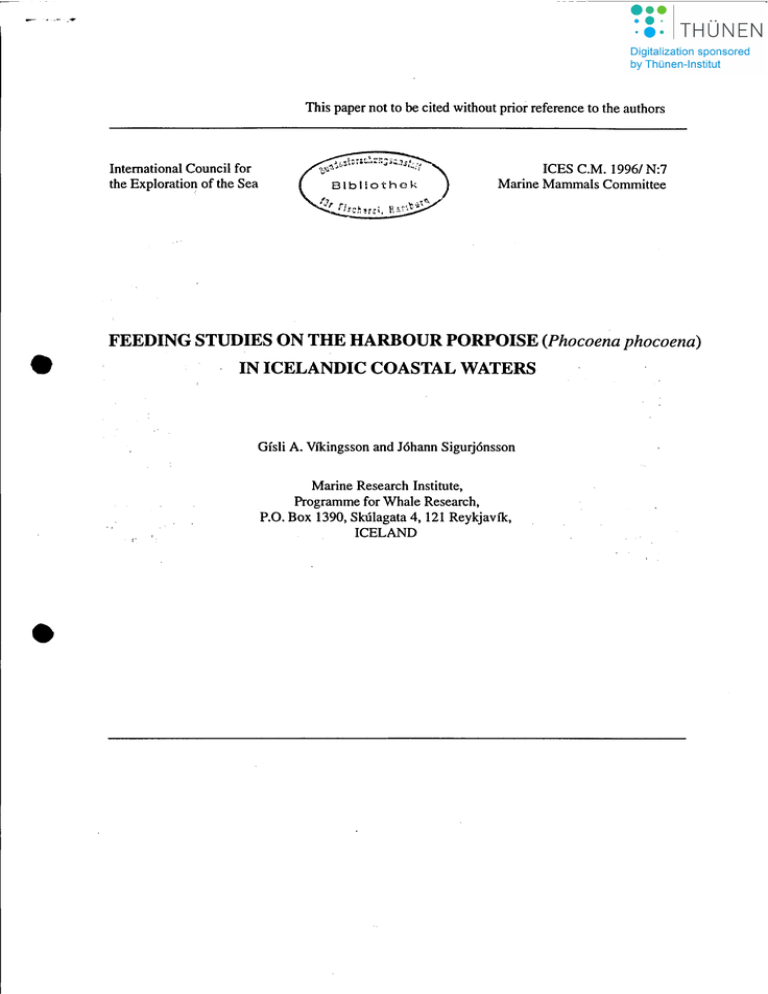
This paper not to be cited without prior reference to the authors
International Council for
the Exploration of the Sea
ICES C.M. 1996/ N:7
Marine Mammals Committee
FEEDING STUDIES ON THE HARBOUR PORPOISE (Phocoena phocoena)
IN ICELANDIC COASTAL WATERS
Gfsli A. Vikingsson and J6hann Sigurj6nsson
Marine Research Institute,
Programme for Whale Research,
P.O. Box 1390, SkUlagata 4, 121 Reykjavik,
ICELAND
.
-2-
ABSTRACT
Harbour porpolse (Phocoena phocoella) is one of the most abundant cetacean species in
coastal Icelandlc waters. Until recently very llmited research had been .conducted on the
species in these waters. As apart of its multi-species research efforts. the Marine
Research Institute (MRI). Reykjavik initiated in 1991 an organized sampling scheme for
harbour porpoises incidentally caught in gillnets. The present paper reports on some
preliminary findings on food and feeding of the species in Icelandic waters during 19911995.
Most of the sampIes were obtained from two areas southwest (SW) and southeast (SE) of
Iceland and the majority were taken in March-April. The sex ratio was skewed in
"favour" of males (mlf: 1.87). The sex ratio and mean lengths of both sexes were higher
in the SE area than in the SW area. More than 95% of all examined stomaehs had
identifiable food remains. Overall capelin (Mal/otlls VillOSllS) comprised the predominant
prey. followed by sandeel (Ammodytidae sp.) and then gadoids and cephalopods. while
other prey groups were of less importance. There was considerable seasonal variation in
prey frequency. where capelin appears to be dominant in late winter and spring and
sand-eel in the summer through early winter. This coincides with the spawning migration
of capelin from northern waters along the east. south and west coasts of Iceland. The
length distribution of the capelln consumed by the porpoises shows predominance of 2-4
year old fish according to analysis of otholiths. The length distribution of sandeel shows
somewhat smaller modallength.
The diet of the harbour porpoise seems less diverse in the present study than in some
other areas that have been investigated. However. the apparent opportunistic feeding
habits of the species. and the non-random nature of the sampling may have contributed to
this homogeneity.
-3-
iNTRODUCTION
.~
The harbour porpoise (Phocoenaphocoena) is one of the most common small cetacean in
coastal Icelandie waters (Sremundsson 1932, Sigurj6nsson and Vfkingsson 1995,
Sigurj6nsson 1993). The global distribution of the species is Iimited to temperate and
subarctie . waters of, the N-hemisphere (Klinowska 1991). The species shows some
seasonality in movements probably as a result of seasonal variations in local prey
4 '. .'..
'. • •
'
a~mlabllIty,: (TomllIn 1957, Gaskm 1992, Berggren and·.Arr~~,mus;.1995). The feedmg
eco'ogy of the harbour popoise has been studied in numerous studies in different parts of
its distribution area (Tomilin 1957, Rae 1964, 1973, Smith and Gaskin 1974, Gaskin et al.
1974, Recchia and Read 1989, Smith and Read 1992, Fontaine et al.' 1994, Aarefjord et
al.-,l995). These studies have shown considerable spatial and temporal variation in the
'
diet of the species.
" ,!, ' " • • •
•
.. ',
I • •
~
1
,
:'
~ , • ,. '.' ,"
•
•
'
Until recently, no systematie studies had been undertaken on the biology arid ecology of
the harbour porpoise in Icelandie waters. The distribution of the species overlaps \vith the
operational area of the coastal fisheries which may cause confiicts of interests
(competition,- bycatch ete.). Calculations, based'on rough approximations of stock size
and food analysis from other areas in the N-Atlantic, have indicated that the total
consumption of harbour porpoises in Icelandie' waters may be in the range of 48,000
tonnes, the bulk of which consists of fish (Sigurj6nsson and Vfkingsson 1992).
As apart of the Marine Research Institute's (MRI) multispecies research programme a
special study. on feeding ecology and life history of the harbour porpoise and whitebeaked dolphin (Lagenorhynchus albirostris) was conducted iri 1992-1995. The present
paper gives same preliminary results on the feeding habits of harbour porpoises while
' .
further analysis ofthe data is underway.
•
l\1ATERIAL AND METHODS
,
.
'
The study is based solelyon the examination of animals caught incidentally in thc gillnet
fishery in nearshore Icelandie waters in 1991-1995. The porpoises were collected either
through contacts at fish markects fishmarkeds or directly from the fishermen by MRI staff
and cooperating individuals throughOllt the country.
Th~ seasonal distribution of t~e sampie is shown in Figure land the geographical
distribution in Figure 2. The sampling is uneven both in time and space. While porpoises
were sampled in all months except July and August, the overwhelming majority of the
sampIes were taken in March and April. Similarly, most of the animals were sampled in
two main sampling areas: off southwestern (SW) and southeastern (SE) Iceland. In the
anlysis below distinction is made between 5 areas: the S\V- and SE-areas, Breiöafjörüur
(W) area, Isafjörüur (NW) area and northeastern (NE) area, the last two containing only
3 and 20 animals, respectively.
-4-
In most cases whole carcasses were received for autopsy by MRI staff members, but in
some cases sampIes were taken by coworkers along the coast. The carcasses were usually
kept frozen until dissection at the laboratory. During dissection the fullness of the
forestomach was visually assessed (empty, 1/4, 1/2 etc.) before the stornach was refrosen
until further laboratory analysis.
.
In the laboratory the weight of the stornach content was estimated by weighing the
stornach before and after the contents had been removed. The state of digestion was
assessed using a five stage scale ranging from fresh newly ingested food (stage 1) to
otoliths or other hard parts being the only food remains (stage 5). The stornach content
was washed through: sieves \vith a mesh size of 0.3mm and then separated
groups before final species identification und measurements. Relatively undigested prey
was identified to species as far as possible and weighed. However, in most of the
stomachs the only identifiable remains were hard parts, otoliths, bones, cephalopod
beaks, etc. The otoliths and cephalopod beaks were identified and measured using
published identification guides (Clarke 1986, Hürkönen 1986) and the MRI's reference
collection.
into ·prey
•
Two methods were used for measuring the otoliths. Apart of the sampIe was measured
using a stereo-microscope with a graticule scale in the eyepiece. As this iso a very time
consuming metod, experiments were made using an image analyzer (Leica Quantimet
500+) for these measurements. Comparison between the two metods revealed no
significant difference (t-test t=0.170 1, df= 19, p=0.8667).
For calculating fish size from otolith size the formulae of Hürkönen (1986) were used
except for capelin (Mal/otlls VillOSllS) where a new formula was created (see below). It
was not considered feasible to distinguish between the otoliths of the three species of
sandeel (Ammodytidae sp.) found off Iceland and therefore Härkönen's formula for
greater sandeel (Ammodytes marinlls) was used to calculate fish length in this group. No
attempt was made to correct for digestion of otoliths so the calculated sizes of fish may
be underestimated.
As a1l measurements of food remains have not been completed, at this stage the different
prey species/groups have been arbitrarily classified as primary, secondary, etc. prey in
each stornach. This classification was primarly based on relative numbers of individuals
of euch prey species found in the stornach. Calculations of original (reconstructed)
weight of stoinach content from otolith size were made on a subsampie of stomachs from
the SW and SE areas containing capelin and sandeel.
During dissection of the porpoises various measurements were made and sampies taken
for related studies such as morphometrics, age and reproductive parameters, parasites,
genetics and energetic studies. These studies are not completed and cannat be
incorporated into the present analysis of the feeding data at this stage.
.
•
-5-
RESULTS'
The Jength and sex distributions of the porpoises sampled in SW and SE subareas is
shown in Figure 3. AJmost twice as many maJes as females were sampled, resulting in an
overall sex ratio (SR: maJes/females) of 1.87. The unequality of the sex proportions was
more pronounced in the SE area (SR=2.33) than in the SW area (SR= 1.54). Harbour
porpoises.of both sexes were significantly Jarger in the SE area (J35.9cm±O.62 s.e. and
t'37;1c'n1±I:lOSE for males and females, respectively) thainil the'SWarea (129.3±0.63
s.e. and J34.2±0.88 s.e.; t-test : t=6.48, p=O.OOO for maJes and t=2.07, df=317, p=0.039
for females).
•
Most af the examined stomaehs contained same food remains. Figure 4 shows
frequencies rif the five visually assessed degrees of stornach fullness. AJthough 16 % of
the stomachs \vere assessed empty by this method, most of these stomaehs contained
some food remains upon cJoser examination.
'
Frequencies of the different prey species present in stomachs are shown in Figure 5,
separateJy foor the different geographical areas. Overall, capelin is cJearJy the dominant
prey speeies, occurring in 86% of the stomachs examined. sandeel was the second most
frequent prey, occurring in 29% of all stomachs, followed by cephalopods and gadoids
with 12 and 10% frequency of occurrence, respectiveIy.
0
•
0
There were some differences between areas in frequency of prey species. In the SE '~reao
capelin was the overwheJming dominant species occurring in 99% of the examined'
stomachs; while sandeeJ, the second most frequent prey was found in onJy 13% and
gädoids' in 1% of the stomachs. In the SW area the diet was more variable, capelin'
occurring' in 71 % of the stomachs, sandeel in 47% and gadoids in 20%. The
Breiöafjöröur area appears to be somewhat more diverse with respect to food selection of
harbour porpoises, with capeJin found in 76% of the examined stomachs, sandeeJ in 44%
and gadoids in 41 %. It is, however noticeabJe that cephaJopods were not observed in
stomaehs from this area (Figure 5). The small sampJe size in this area (n = 60) must,'
however, be borne in mind. .
The dominance of capeJin as a prey speCies in the totaJ sampIe is even more cJear when'
the assessed relative importance of prey species is eonsidered. In 96% of aJI stomachs
eontaining eapeJin, it was the primary prey species, while sandeeI, gadoids and
cephalopods were considered primary prey in respectiveJy 38, 25 and 10% of the eases
when they were found in stomachs.
Figure 6 shows the seasonal variation in relative frequency of primary prey
species/groups for the S\V and SE areas. Although the sampIe size is very small in the
SW area during June-September and December-February seasonal variation is evident
from the data. CapeJin increases in frequency during February to April, decreasing
thereafter sharply in May, and is absent asa primary prey species in June. For the rest of
the year, capeJin was found onJy in four stomachs as a primary prey species. From the
Jatter part of May the role of eapelin seems to be taken over by sandeeI, and to a lesser
degree gadoids and other fish species.
-6-
As indicated above, the diet in the SE area is overwhelmingly dominated by capelin.
However, the sampling period in this area was limited to the months March-May. The
apparent diffcrence in prey composition between the S\V and SE areas in May (Figure 6)
is probably caused by the fact that no sampies were taken in the SE area after 7 May.
A preliminary investigation rcvealed no significant differences in prey composition
between sexes nor with respect to sexual maturity. However, the relationship between
diet on one side und age and reproductive status on the other awaits further analysis.
Calculations of original weight of stornach content from the size of hard food remains
have not been completed. Preliminary calculations of length distribution of capelin using
Härkönen's (1986) relationship between otolith length (OL) and fish contradicted MRI's
research on capelin from the same year and area (H. Vilhjalmsson pers.commn.). The
relationship between otolith length and fish length was therefore investigated in a sampie
of capelin from Icelandic waters in 1995. The results are shown in Figure 7. The
Icelandic capelin clearly has a higher fish-lengthlotolith-length ratio than the sampie
used by Härkönen.
The calculated length distribution of capelin, using the new formula (Figure 7) is shown
in Figure 8. No significant difference was observed between the two main sampling
14-15cm in both areas, corresponding to capelin of ages
areas. The peak length class
2 and older (Vilhjalmsson 1994). All available length classes of capelin during spring
were, however, represented to some degree i.n the porpoise's stornach.
•
was
Figure 9 shows the length distribution of sandeel (Ammodytidae sp.) as calculated from
otolith lengths using Härkönens formula for Ammodytes marill11s. The total size range
(approximately 5-20cm) is similar to the size range of capelin found in the stomachs, but
the mean length is considerably smaller (t-test p<0.05). There was no significant
difference in the length of sandeeI, found in porpoise stomachs in the SW and SE areas.
Figure 10 shows the frequency distribution of the reconstructed weight of stornach
content in animals from the SW and SE areas containing sandeel and/or capelin. There
was no significant difference in total weight of stornach content between the two areas;
There was wide variation in the calculated stornach content although most animals
contained less than 1kg. In stomachs containing capelin the calculated weight of that
species ranged from 0.6g to 4,431g (mean=690g, n: 290, SD: 723) while the
corresponding figures for sand eel were 0.3g-6,146g (mean=600g, n: 120, SD: 1,306).
DISCUSSION
The uneven distribution of the sampling in time and space probably reflects both the
sampling effort (Le. the distribution of the gillnet fishery in Icelandic waters), the
spawning migration of capelin and possible inshore/offshore migrations of luii-bour
porpoises. The peak of the gillnet season is in March-April and is most concentrated off
S\V and SE Iceland. The main target species of the gillnet fishery are cod (Gadlls
morhlla), saithe (PollachilIs virelzs) and haddock (Mela1Zogra11Z11Z11s aeglefi1Z11s). This
fishery coincides in time and space with the spawning migration route of capelin. The
•
-7-
main spawning grounds are off south and west Iceland, the first migrations generally
arriving in the coastal waters off southeast Iceland in February and eontinuing westward
along the south coast (Vilhjalmsson 1994). The spawning takes place mostly in MarchApril. No systematic studies have been undertaken on the seasonal distribution of
harbour porpoises around Iceland, but Sremundsson (1932) described the harbour
porpoise in Icelandic waters as migratory, arriving in coastal areas in March, seemingly
following the eapelin.
The high. proportion of males in the sampIe and the difference. in. length distributions
bet\\i~en 'arehs (Figure 3) may indieate some kind of temporal a~dJo~: spatial segregation
in' th~ stock: Further analysis of the distribution with resreet .to ag'e and reproduetive
s~aius i.s underway.
.
•
•
The 'present study agrees with most earlier studies that the harbour porpoise feeds
predominantly on fish although cephalopods, erustaceans and other invertebrates have
beenidentified as minor componentsof the diet (Tomilin 1957, Rae 1973, Smith and
Gaskin 1974, Recchia' and' Read 1989, Smith and Read 1992, Palka und Read 1995,
Aarefjord et ai. 1995, Teilmann and Dietz 1995, Santos et ai. 1994, 1995). According to
these studies the harbour porpoise feeds on wide variety of fish species in the N-Atlantic.
Although herring seems to be the most important prey species on both sides of the NAtlantic (Smith and Gaskin 1974, Aarefjord et ai. 1995, Recchia und Read 1989) capelin
has been identified as an improtant component off N-Norway (Aarfjord et a1. 1995),
Greenland (Teilmann and Dictz 1995) and Canada (Fontaine et ai. 1994). Other
important prey groups in the N-Atlantic include hake (Merluccius sp.) (Recchia and
Read 1989, Smith and Rcad 1992, Aarfjord et a1. 1995, Teilmann 1995), sandee1 (Santos
et ai. 1995, Aarfjord et ai. 1995) and members of the eod family (Gadidae) (Rae 1973,
Aarefjord et al. 1995, Santos et a1. .1994).
Overall, capelin \vas the predominant prey spccies fn the present study (Figure 5)~ The
conslunption of capelin seems, however, to be mostly limited to few months of the year,
aIld 'the seasonal distribution of prey frequencies (Figure 6) indicates that sandeel and to
a lesser clegree gadoids are more important 'components of the annual food consumption
than indicated by' the pooled sampIe. However,' during the capelin spawning period
porpoise fceding activity seems to be intense, judging from the high proportion of
irtv'cstigated 'stomachs with identifiable food remains compared to most other studies
(Smith and Gaskin 1974, Recchia and Read 1989, Fontaine et a1. 1994, Aarefjord et ai.
1995):' This may reflect the seasonal and geographical nature of the present sampIe,
coinciding with the abundant food supply of the capelin spawning migration. Seasonal
changes in diet have also been found in other areas (Tomilin 1957, Smith and Read 1992,
Palka and Read 1995, Santos et ai. 1995). An assessment of the relative importance of
different prey species on an annual basis using reconstructed weight of stornach contents
is underway. Energetic studies mayaIso indicate possible seasona1 variation in fecding
rates related to the capelin migration.
The apparent similarity of food' composition between sexes and length classes of
porpoises in the present study is in agreement with studies from Canada (Smith and
Gaskin 1974) und Scundinavia (Aarefjord et ai. 1995).
-8-
The use of image analyzer greatly enhanced the efficiency in otolith measurements as
upto 50 otoliths can be measured at a time. The technique also has other potentials, such
as species identification as various aspects of shape (length, width, area, roundness, etc,)
can be automatically measured at the same time.
The 'calculated size range of capelin and sandeel taken by the porpoises (Figures 8-9) is
within the size range of fish prey reported from other areas (Fontaine, er a1. 1994, Santos
er al., 1994).
Although analysis of the p~esent material is not completed, the preliminary resu!ts
confirm the primarly ichtyophagous feeding habits of harbour porpoises. Off ICel~n'd!
capelin and sandeel appear to be the most important prey species, and there is great
seasonal variation in the relative importance of these two key species. During the
spawning migration of capelin into coastal waters during late winter/spring it is c1early
the overwhelming dominant prey species of the harbour porpoise in the areas covered in
this study. \Vhether this applies to the stock in general remains unresolved until further
sampling from other areas. Further analysis of the available data will inc1ude assessment
of the relative importance of different prey items based on calculated weight (Pierce and
Boyle 1991), analysis of the stornach content with respect to age, sex, reproductive
status, energetic condition and calculations of annual consumption rates of different prey
species.
•
ACKNO\VLEDGEMENTS
Special thanks are due to Sverrir D. Halld6rsson, Inga F. Egilsd6Uir of the Marine
Research Institute, Reykjavik who played major role during most stages of this
investigation. The following helped during various phases of handling' of animals,
dissection and analysis of sampIes: Magmls' Astvaldsson, J6n PalI Baldvinsson,
Gudmundur Kr. Gudmundsson, Hilmar Th. Gudmundsson, Hjalti Karlsson, PalI Leifsson,
Droplaug Olafsd6uir, Magnus Olafsson, Run6lfur Run6lfsson, Birgir Stefansson,
Sigurdur Sveinsson, Eyth6r Th6rdarson, Haraldur Th6rmundsson, J6n Thorsteinsson.
Valur Bogason, Haraldur Einarsson, Anton Galan and Kristjan Lilliendahl, all at the MRI
provided help in identification of part of the stornach sampIes. We thank aIi these people
as weIl as the many fisherman along the coasts of Iceland for their valuable contribution
.
to th~s project.
REFERENCES
Aarefjord, H., Dj~rge, AJ., Kinze, C.C. and Lindstedt, I. 1995. Diet of the harbour porpoise (Phocoena
phocoena) in Scandinavian Waters. Rep.Int.\Vha1.Commn (SPECIAL ISSUE 16): 211-222.
Denke, H. and Siebert, U. 1995. The current status of harbour porpoises (Phocoena phocoena) in German
\Vaters. Paper SCl47/SM49 submitted to the Scientific Committee of the International
\Vhaling Commission. 30 pp.
Derggren. P. and Arrhenius F. 1995. Densities and seasonal distribution of harbour porpoises (Phocoena
.
phocoena) in the Swedish Skagerrak, Kattegat and Daltic Seas. Rep.Int.\VhaI.Commn
•
-----
----
--------------------------
-9-
•
•
(SPECIAL ISSUE 16): 109-121.
Clarke, M.R. 1986. A handbook for the identification of cephalopod beaks. Clarendon Press, Oxford.
273 pp.
Fontaine, P.M., Hammill, M.O., Barrette, C., Kingsley, M.C. 1994. Summer diet of harbour porpoise
(Phocoena phocoena) in the Estuary and the Northern Gulf of St. Lawrence.
Can.1.Fish.Aquat.Sci. 51: 172·178.
Gaskin, D.E. 1992. Status ofthe harbour porpoise, Phocoena phocoena, in Canada. Can. Field Naturalist
106( 1): 36-54.
Gaskin, D.E., Arnold, P.W. and Blair, B.A. 1974. Phocoena phocoena. Mamm. Species 42: 1-8.
Harkönen, T. 1986. Otholiths ofthe bony fishes. Danbiu ApS. 256 pp.
Klinowska, M. 1991. Dolphins, porpoises and whales of the World. The IUCN Red Data Book. 429 pp.
Palka, D. and Read, A. 1995. Summary of current knowledge of harbour porpoises in US and Canadian
waters of the NW Atlantic. Paper SC/47/SM23 submitted to the Scientific Committee of the
International Whaling Commission. 10 pp.
Pierce, G.J., and Boyle, P.R. A review of methods for diet analysis in piscivorous marine mammals.
Oceanogr.Mar.Biol.Annu.Rev. 29: 409-486.
Rae, B.B., 1965. The food of common porpoise (Phocoena phocoena). 1. Zool., Lond. 146: 114-22.
Rae, B.B. 1973. Additional notes on the food of the common porpoise (Phocoena pllOcoena). J. Zool.,
Lond.169: 127-131.
Recchia, C.A. and Read, A.1. 1989. Stomach contents of harbour porpoises, Phocoena phocoena (L),
from the Bay ofFundy. Can. J. Zool. 67: 2140-2146.
Santos, M.B., Pierce, G.J., Wijnsma, G., Ross, H.M. and Reid, RJ. 1995. Diets of small cetaceans stranded
in Scotland 1993-1995. ICES C.M. 19951N:6. 8 pp.
Santos, M.B., Pierce, G.1., Ross, H.M., Reid,R.J. and Wilson,B. 1994. Diets of small cetaceans from
Scottish coast. ICES. C.M. 19941N:11. 16 pp.
Sigurj6nsson, J. 1993. Hvalranns6knir vii} fsland. P. 103-146 In Hersteinsson, P. and Sigbjarnason, G.
(eds.): Villt fslensk spendyr. H.f.N. and Landvernd 1993. 351pp.
Sigurj6nsson, J. and Vfkingsson, G.A. 1995. Estimation of food consumption by cetaceans in Icelandic
and adjacent waters. Paper presented at the NAFOIICES symposium on the role of marine
mammals in the ecosystem, Dartmouth, Nova Scotia, Canada, 6-8 September 1995.23 pp.
Smith, G.J.D. and Gaskin, D.E. 1974. The diet of harbour porpoises (Phocoena phocoena (L) in coastal
waters of Eastern Canada,' with special refercnce to the Bay of Fundy. Can. J. Zool. 52: 777782.
porpoise (Phocoena
Smith, R.J. and Read, A.J. 1992. Consumption of euphausiids by harbour
phocoena) calves in the Bay ofFundy. Can.J.Zool. 70: 1629-1632.
Sremundsson, B. 1932. fslensk dyr 11: SpendYrin. B6kaverzlun Sigftisar Eymundssonar, Reykjavfk, 1932.
437 pp.
Teilmann, J. Dietz R. 1995. Status of the harbour porpoise (Phocoena phocoena) in Greenland. Paper
SC/47/SM44 submitted to the Scientific Committee ofthe International Whaling Commission.
24pp..'
.
Teilmann, J. 1995. Status of the harbour porpoise (Phocoena pllOcoena) in Danish waters. Paper
SCl47/SM46 submitted to the Scientific Committee ofthe International Whaling Commission.
22pp.
Tomilin, A.G. 1957. Mammals of the U.S.S.R. and adjacent countries. Israel Program for Scientific
Translations, Jerusalem 1967. 716 pp.
.
Vilhjalmsson, H. 1994. The Icelandic capelin stock. Capelin, Mal/otus villosus (Muller) in the Iceland Greenland - Jan Mayen area. Rit Fiskideildar. 281 pp.
Figure 1. Seasonal distribution of stornach sampies
in the four geographical areas (~~~..~ig. 2)
•
300
250
ro-
o SW-area, N=488
I·
• SE-area, N=512
In
-ä 200
-
C'O
In
-
•E
150
.
0
ci 100
-
-
z
"
50
.....
0
Jan
Feb
"
,
-
-
I,
LL,;._
I'
Mar
Apr
•
fl n
1"1
May Jun
Jul
Aug
n
Sep
Oct
Nov Dec
Sep
Oct
Nov
o
C'I
•
. 0 NE-area, N=20
In
..• W-area, N=61
~
Co
E
- ,..
C'O
In
0
o
ci
z
o
Jan
Feb
Mar
Apr
May Jun
Jul
Aug
Dec
Figure 2. Harbour porpoise - Sampling distribution off leeland.
The number of animals sampled in subsquares. letters indicate the 5 sampling areas.
67°00'
66°30'
66°00'
65°30'
, 65°00'
64°30'
64°00'
63°30'
63°00'
62°30'
25°
24°
23°
22°
21°
20°
19°
18°
17°
16°
15°
13°
12°
Figure 3. Length distribution 01 harbour porpoises
sampled SW and SE off leeland.
70 -....-------------1"---:-:----:-:---:-:-_____.--:-:---:-:---:-:----,
o Males· 129.3crn, N=289
...
60 .
• Females • 134.2crn,
N=187
SW-area
50
(I)
ca
.5
fä
-
.
~
'.
).",
;
;
':
~
:
I
I
40
30·
o
I·
'0'20
z
10
0
~fl
• ....
.... ....
i
rI~
0
0
I
IJ')
0
I
I
I
0
I
I
U)
U)
Q)
0
IJ')
CO)
IJ')
CO)
I
I
U)
U)
0
IJ')
I
CO)
I
0
IJ')
IJ')
IJ')
U)
IJ')
U)
I
I
I
I
I
IJ')
U)
IJ')
U)
U)
U)
U)
U)
CO)
0
-
.:.;;,
o:t
.... ....
0
.,.. C\I C\I .... .... ....
....o:t .... ........ .... .... .........
. ....
.... ....
.,..
.,..
....
....
.... ........ ....C\I ....C\I .... .... ....o:t o:t.... .... .... ........ ....
....0 ....0 ....
IJ') .
0
IJ')
0
.....,....... ....co
......... .........
I
I
U)
Length elasses (ern)
G Males· 135.9srn, N=307
70
• Females - 137.1 sm,
60
SE;;.area
50
(I)
ca
.5c
N=132
...
40
-
ca 30
.
...
0
;..
I,
...
...
I'
0 20
z
I,
10
0
_r-.
~
11I
I·
I rW
-
~
•
0
.... ........0 ........ ............ .... ........ .... ........ ....o:t ........o:t .... ........ .... ........ ......... ............. ....co
....0 ....0 ........ ........ .... .,.. .... .... ....o:t ....o:t .... .... .... .... ......... .........
0
0
IJ')
I
U)
Q)
I
0
I
U)
IJ')
I
IJ')
0
C\I
C\I
I
I
U)
C\I
0
CO)
IJ')
CO)
I
I
C\I
CO)
U)
0
IJ')
0
IJ')
I
U)
CO)
I
I
U)
Length classes (ern)
IJ')
IJ')
I
IJ')
0
U)
IJ')
U)
I
I
In
U)
U)
0
IJ')
I
U)
U)
I
I
U)
Figure 4. Visual assessment of stomach fullness
1/4 (30.6%)
Empty (16.2%)
1/2 (22.3%)
full (16.9%)
"
,',
-.,':
....
3/4 (14.0%)
Figure 5. Frequency of prey'roups in three geographAI areas off leeland.
Prey groups are classified as primary (1°), secondary (2°) etc.
according to estimated relative importance.
,
Other
SE-area
Other fish
W-area
Other fish
N=505
Cephalopods
Other
-N=60
Gadoids
Gadoids
Sandeeis
Sandeeis
f--'-'
Capelin
Capelin
o
100
200
300
400
o
500
10
5
No. of stomaehs
15
20
25
30
No. of stomaehs
Other
SW-area
Other fish
N=399
Cephalopods
Gadoids
Sandeeis
Capelin
o
50
100
150
200
250
No. of stomaehs
300
350
.
Figure 6. Primary prey species: relative
seasonal variation in frequency.
100%
N= 4
64
187 42
9
2
36
24
12
....-r-r-......--r--=::r--"T""""'lr_'r--r-----r-~"'T""""1r_'.,...._,..-
SW-area
. N::380
75%
50%
25%
Feb Mar Apr May Jun
mn Cephalopods .
100%
Aug Sep Oct Nov Dec
~ Sandeeis
[J Capelin
.
Jul
[iJ Gadoids
[J Other fish
.
N= 210 '242 10
. .'.
'
--------------t
·SE-area
N=462
. I··
.....
;
.-:- .... -.:.. ' / - - - - - - - - - - - - - - - - 1
75%
50%
4---1
-
-' /----------------1
25%
4---1
-
-. I-------:---------i
0% +--f--IIllI~~-'--.L_j_ ........._t_-_r____+-_+-_+_-+____1I____I
Feb Mar Apr May Jun
Jul Aug Sep Oct Nov Dec
Figure 7. Capelin - relationship between otolith length (OL) and tish length (FL).
The solid /ine shows the regression line tor the Icelandic data while the dotted (ine snows the relafionship given by Harkönen (1986)
**
o
C\J
FL
= 17.19 + 55.579 OL
Multiple R-Square
=0.8599
**
**
P = 0.000
**
...-
E
u
-...-
c:
Q)
LC)
0.'-
co
U
o
.c:
+J
0>
c:
Q)
....J
0
,-
**
1.0
1.5
2.0
Otolith length (mm)
2.5
3.0
Figure 8. Length distribution of capelin consumed by harbour porpoises,
as calculated fram otolith lengths
0
0
LO
,...
SE - Area
11
c
Q)
E
~
0
0
0
,...
::J
(J)
ro
Q)
E
0
ci
z
0
0
LO
lI_-
--_.••11111
0
. 100
50
•
150
200
Capelin length (mm)
'
..
0
0
LO
,...
'SW'~
. .
-
e
Area
' .
(J)
c
E
Q)
Q)
...
::J
0
0
0
,...
."
(J)
ro
Q)
E
:J:
0
cl
z
0
0
~.
LO
0
1••_-
·_.••11111
50
100
150
Capelin length (mm)
200
Figure 9. Length distribution of sand eel consumed by harbour porpoises
.
as calculated tram otolith lengths
SE - Area
0
~
(~)
"'\ ~
~~
,
'
...
C1l
'E
Q)
0
C")
E
Q)
....
:J
C1l
l1l
Q)
E
<5
0
C\I
ci
z
0
....
e
I
I
0
50
.
11.11 ---- ....I
...
I.
100
;
150
200
Length of sand eel (mm)
0
0
0
C")
"l
•
k-,
SW - Area
t
0
0
':
l{)
C\I
"!'
:';
,
,
;:~
~.:
...c:
C1l
0
0
0
C\I
'1
Q)
.~
E
Q)
....:J
C1l
l1l
Q)
E
z
,
~
.
0
0
i
....
l{)
;
0
ci
,
r'!
,.
'.,J
~
., ,
.: .
~
#'.
19_
0
0
0
....
0
0
l{)
o
.:,_1
50
100
150
Length of sand aal (mm) 1
200
Figure 10. Reconstructed weight of stornach content
as calculatedlrom the size and numbers of capelin and/or sand eel otoliths
oC")
SW - Area
(/)
(ij
E
'2
tU
Ö
0
C\I
ci
z
o
,...
11•••..•
o
o
1000.
1•••_. I
2000
3000
4000
5000
- -
•
6000
yveight of stomach contents (g)
,
....
LO
C\I
o
(/)
.c
g
•
SE - Area
C\I
LO
,...
E
o
Ci)
Ö
ci
0
z ,...
..
.
1111.
o
o
1000
2000
Weight of stomach contents (g)
3000
--
4000
FJöLRITUNARSTOFA
DANIELS HALLDÖRSSONAR
